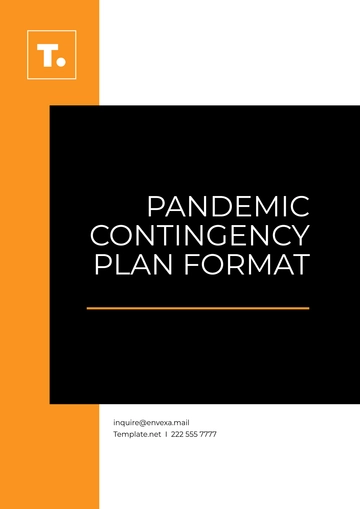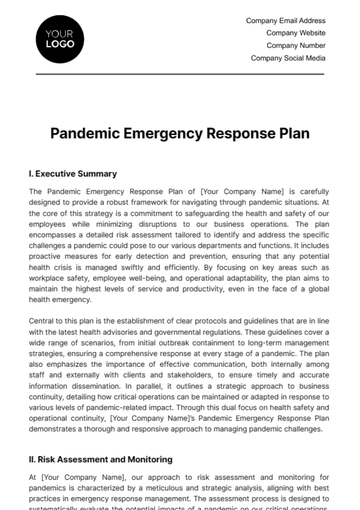Free Pandemic Emergency Response Plan

I. Executive Summary
The Pandemic Emergency Response Plan of [Your Company Name] is carefully designed to provide a robust framework for navigating through pandemic situations. At the core of this strategy is a commitment to safeguarding the health and safety of our employees while minimizing disruptions to our business operations. The plan encompasses a detailed risk assessment tailored to identify and address the specific challenges a pandemic could pose to our various departments and functions. It includes proactive measures for early detection and prevention, ensuring that any potential health crisis is managed swiftly and efficiently. By focusing on key areas such as workplace safety, employee well-being, and operational adaptability, the plan aims to maintain the highest levels of service and productivity, even in the face of a global health emergency.
Central to this plan is the establishment of clear protocols and guidelines that are in line with the latest health advisories and governmental regulations. These guidelines cover a wide range of scenarios, from initial outbreak containment to long-term management strategies, ensuring a comprehensive response at every stage of a pandemic. The plan also emphasizes the importance of effective communication, both internally among staff and externally with clients and stakeholders, to ensure timely and accurate information dissemination. In parallel, it outlines a strategic approach to business continuity, detailing how critical operations can be maintained or adapted in response to various levels of pandemic-related impact. Through this dual focus on health safety and operational continuity, [Your Company Name]’s Pandemic Emergency Response Plan demonstrates a thorough and responsive approach to managing pandemic challenges.
II. Risk Assessment and Monitoring
At [Your Company Name], our approach to risk assessment and monitoring for pandemics is characterized by a meticulous and strategic analysis, aligning with best practices in emergency response management. The assessment process is designed to systematically evaluate the potential impacts of a pandemic on our critical operations, workforce capacity, and supply chain integrity. We scrutinize various risk factors, such as reduced staffing due to illness or quarantine, disruptions in supply chain logistics, and limitations in operational output under pandemic constraints. This comprehensive risk profiling enables us to preemptively identify vulnerabilities and implement targeted mitigation strategies.
In monitoring pandemic developments, our focus is on leveraging real-time data from authoritative sources like the World Health Organization (WHO) and local health agencies. This vigilance is crucial for staying abreast of evolving pandemic trends, assessing the efficacy of ongoing public health measures, and anticipating shifts in the pandemic’s trajectory. Our team maintains a robust network for knowledge exchange with industry experts and counterparts, ensuring that our response strategies are informed by a broad spectrum of insights and are aligned with global standards.
III. Emergency Response Team and Contact Information
The Pandemic Response Coordinator oversees the plan's implementation, supported by the Health and Safety Officer, who focuses on workplace safety measures. Contact information for all key team members is provided for ease of communication.
Pandemic Response Coordinator | [Name] | [Office number, mobile number, email address] |
Health and Safety Officer | [Name] | [Office number, mobile number, email address] |
Pandemic Response Assistant Coordinator | [Name] | [Office number, mobile number, email address] |
Health and Safety Assistant Manager | [Name] | [Office number, mobile number, email address] |
IV. Prevention and Mitigation Strategies
In our efforts to combat the spread of a pandemic, [Your Company Name] employs a multifaceted approach to prevention and mitigation, emphasizing both individual health practices and organizational adjustments.
A. Health and Hygiene Protocols:
a. Hand Hygiene: We strongly advocate and enforce regular and thorough hand washing among all employees. Hand sanitizing stations are strategically placed throughout the workplace, especially in high-traffic areas.
b. Respiratory Etiquette: Employees are encouraged to follow best practices in respiratory hygiene, including the use of tissues or elbow-covering when coughing or sneezing, followed by immediate hand washing or sanitizing.
B. Social Distancing Measures:
a. Workplace Layout Adjustments: We reconfigure workspaces to ensure adequate distance between employees. This may involve rearranging desks, limiting access to common areas, and implementing directional flow in hallways.
b. Limiting Physical Meetings: In-person meetings are minimized, with a preference for virtual communication platforms. Essential meetings that must occur in person are conducted in well-ventilated spaces with limited participants to maintain social distancing.
C. Enhanced Cleaning and Disinfection:
a. Regular Cleaning Schedules: We implement intensified cleaning and disinfecting routines, focusing on frequently touched surfaces such as doorknobs, elevator buttons, and shared equipment.
b. Use of Effective Disinfectants: Cleaning staff are equipped with EPA-approved disinfectants, ensuring effective sanitization against the virus.
D. Workforce Management Strategies:
a. Staggered Shifts: To reduce the number of employees in the facility at any given time, we implement staggered shifts. This approach not only minimizes contact among employees but also allows for more flexible transportation options.
b. Remote Work Options: Where feasible, employees are encouraged to work from home to minimize physical interaction in the workplace.
V. Communication Plan
Our communication plan ensures timely and accurate dissemination of information to employees and stakeholders. This includes updates on company policies, health advisories, and any changes to operations due to the pandemic.
VI. Employee Health and Safety Measures
[Your Company Name] prioritizes the health and safety of our employees, especially during a pandemic. Our comprehensive approach encompasses several key measures:
A. Provision of Personal Protective Equipment (PPE):
We ensure a sufficient supply of essential PPE, including masks, gloves, and face shields, particularly for employees in roles where social distancing is challenging.
Employees are provided with instructions on the correct use, disposal, and maintenance of PPE to maximize its effectiveness in preventing virus transmission.
B. Health Screening and Monitoring
Implementing health screening procedures at entry points, including temperature checks and symptom questionnaires, helps in early detection and prevention of potential virus spread within the workplace.
In cases where an employee is suspected or confirmed to have been exposed to the virus, we have a clear protocol that includes immediate isolation, contact tracing, and appropriate medical referrals.
C. Guidelines for Symptomatic Employees
Employees are instructed to promptly report if they exhibit symptoms consistent with the virus, have been in contact with a confirmed case, or have recently traveled to high-risk areas.
Symptomatic employees are advised to self-isolate and seek medical guidance, minimizing the risk of contagion at the workplace.
D. Sick Leave and Remote Work Policies
We provide supportive sick leave policies, allowing employees who are unwell or need to care for sick family members to take the necessary time off without fear of penalization.
For roles that permit, we offer the option to work remotely, providing the necessary tools and technology to ensure seamless continuity of operations. This not only helps in maintaining social distancing but also supports employees who may be at higher risk or have caregiving responsibilities.
VII. Business Continuity and Operations Management
To ensure business continuity, we identify critical operations and establish remote work protocols, supported by necessary technology infrastructure. Our plan also includes strategies for managing disruptions in supply chains and essential services.
VIII. Recovery and Post-Pandemic Planning
Post-pandemic, we focus on safely resuming normal business operations, including providing wellness support to employees and evaluating the overall response to enhance future preparedness. This phase is crucial for learning and adapting our strategies based on recent experiences.
IX. Plan Review and Updates
Comprehensive training programs are in place, including annual earthquake response drills. These exercises are designed to familiarize staff with evacuation routes and safety procedures, ensuring preparedness for an actual event.
X. Plan Review and Maintenance
The plan is subject to regular reviews and updates to reflect new insights, evolving health guidelines, and lessons learned from our pandemic response. This ensures that our strategies remain relevant and effective in managing future pandemic situations.
Prepared by:
[Your Name],
[Your Job Title]
[Your Company Name]
- 100% Customizable, free editor
- Access 1 Million+ Templates, photo’s & graphics
- Download or share as a template
- Click and replace photos, graphics, text, backgrounds
- Resize, crop, AI write & more
- Access advanced editor
Introducing the Pandemic Emergency Response Plan Template from Template.net. Crafted for adaptability, this editable and customizable template equips you with a comprehensive framework to tackle unforeseen crises efficiently. Utilize our intuitive Ai Editor Tool to tailor your response strategies swiftly. Safeguard your organization effectively with Template.net's cutting-edge solutions.
You may also like
- Finance Plan
- Construction Plan
- Sales Plan
- Development Plan
- Career Plan
- Budget Plan
- HR Plan
- Education Plan
- Transition Plan
- Work Plan
- Training Plan
- Communication Plan
- Operation Plan
- Health And Safety Plan
- Strategy Plan
- Professional Development Plan
- Advertising Plan
- Risk Management Plan
- Restaurant Plan
- School Plan
- Nursing Home Patient Care Plan
- Nursing Care Plan
- Plan Event
- Startup Plan
- Social Media Plan
- Staffing Plan
- Annual Plan
- Content Plan
- Payment Plan
- Implementation Plan
- Hotel Plan
- Workout Plan
- Accounting Plan
- Campaign Plan
- Essay Plan
- 30 60 90 Day Plan
- Research Plan
- Recruitment Plan
- 90 Day Plan
- Quarterly Plan
- Emergency Plan
- 5 Year Plan
- Gym Plan
- Personal Plan
- IT and Software Plan
- Treatment Plan
- Real Estate Plan
- Law Firm Plan
- Healthcare Plan
- Improvement Plan
- Media Plan
- 5 Year Business Plan
- Learning Plan
- Marketing Campaign Plan
- Travel Agency Plan
- Cleaning Services Plan
- Interior Design Plan
- Performance Plan
- PR Plan
- Birth Plan
- Life Plan
- SEO Plan
- Disaster Recovery Plan
- Continuity Plan
- Launch Plan
- Legal Plan
- Behavior Plan
- Performance Improvement Plan
- Salon Plan
- Security Plan
- Security Management Plan
- Employee Development Plan
- Quality Plan
- Service Improvement Plan
- Growth Plan
- Incident Response Plan
- Basketball Plan
- Emergency Action Plan
- Product Launch Plan
- Spa Plan
- Employee Training Plan
- Data Analysis Plan
- Employee Action Plan
- Territory Plan
- Audit Plan
- Classroom Plan
- Activity Plan
- Parenting Plan
- Care Plan
- Project Execution Plan
- Exercise Plan
- Internship Plan
- Software Development Plan
- Continuous Improvement Plan
- Leave Plan
- 90 Day Sales Plan
- Advertising Agency Plan
- Employee Transition Plan
- Smart Action Plan
- Workplace Safety Plan
- Behavior Change Plan
- Contingency Plan
- Continuity of Operations Plan
- Health Plan
- Quality Control Plan
- Self Plan
- Sports Development Plan
- Change Management Plan
- Ecommerce Plan
- Personal Financial Plan
- Process Improvement Plan
- 30-60-90 Day Sales Plan
- Crisis Management Plan
- Engagement Plan
- Execution Plan
- Pandemic Plan
- Quality Assurance Plan
- Service Continuity Plan
- Agile Project Plan
- Fundraising Plan
- Job Transition Plan
- Asset Maintenance Plan
- Maintenance Plan
- Software Test Plan
- Staff Training and Development Plan
- 3 Year Plan
- Brand Activation Plan
- Release Plan
- Resource Plan
- Risk Mitigation Plan
- Teacher Plan
- 30 60 90 Day Plan for New Manager
- Food Safety Plan
- Food Truck Plan
- Hiring Plan
- Quality Management Plan
- Wellness Plan
- Behavior Intervention Plan
- Bonus Plan
- Investment Plan
- Maternity Leave Plan
- Pandemic Response Plan
- Succession Planning
- Coaching Plan
- Configuration Management Plan
- Remote Work Plan
- Self Care Plan
- Teaching Plan
- 100-Day Plan
- HACCP Plan
- Student Plan
- Sustainability Plan
- 30 60 90 Day Plan for Interview
- Access Plan
- Site Specific Safety Plan

